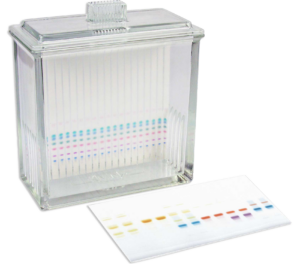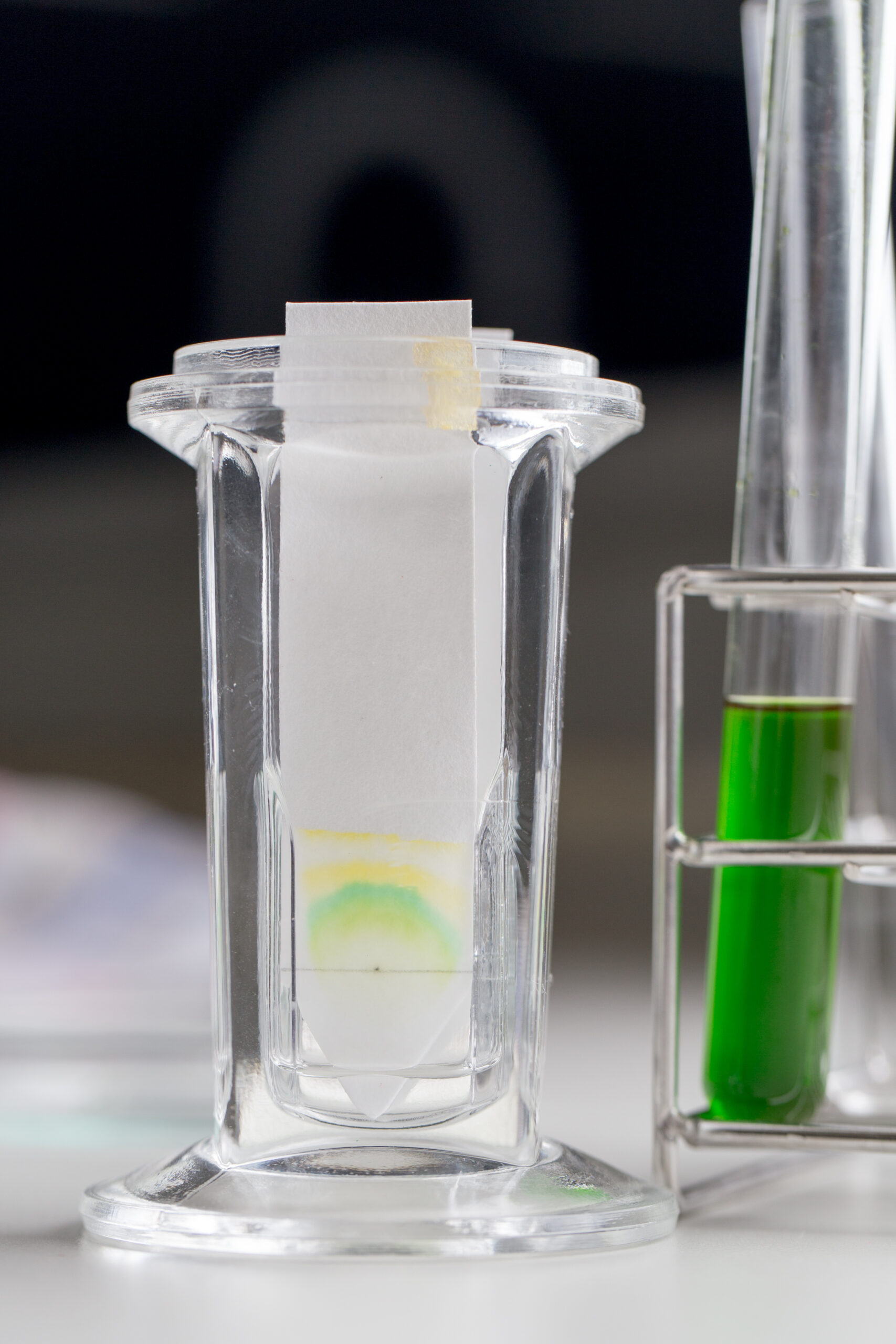TLC Plates (Thin Layer Chromatography)
Rediscover the Power of Thin Layer Chromatography Using TLC Plates
 TLC Plates (thin layer chromatography) might be one of the most undervalued methods of chromatographic analysis for the separation and identification of chemical substances.
TLC Plates (thin layer chromatography) might be one of the most undervalued methods of chromatographic analysis for the separation and identification of chemical substances.
Thin Layer Chromatography provides:
- Rapid results and inexpensive operation
- Qualitative data for compound identification and purity
- The ability to monitor the progress of chemical reactions
- Aid in developing optimal methods
- Quantitative data with the proper instrumentation
Benefits of TLC
TLC is the chromatographers’ fast-lane choice for:
- Ultra-fast solvent and gradient optimization prior to HPLC
- Determining the number of major compounds present in a mixture
- Quick assessment and monitoring of both biotransformations and synthetic reactions
- Choosing the appropriate solvent system for column and flash chromatography
- Simultaneous analysis of several samples under identical conditions
Enhanced quality control & extensive product portfolio
Our plates are manufactured with stringent production controls. TLC layers are smooth, homogenous, uniform, and reproducible from plate-to-plate and lot-to-lot.

Expand your method applications with our comprehensive selection
- Silica gel, alumina, or bonded phases
- With or without UV254 indicator
- Glass, plastic, or aluminum backings
- In a variety of sizes from 20 x 20cm to 2.5 x 7.5cm
Sorbtech Rocket – Small-Scale TLC Development Chamber
Method for Conditioning TLC Plates
A conditioning method is used to ensure performance from plate to plate, lot to lot, and chemist to chemist.
By prepping and conditioning your plates, you will avoid having to rerun your sample or risk the decomposition of your compound. Follow these quick and easy steps:
- Always pre wash your TLC plate with either methanol or methanol/chloroform. Let plate sit overnight in a vent hood.
- To extract the prewashing, use the solvent system of choice for your sample and let this develop to the top of the plate. Again leave in a vent hood overnight.
- Next dry in a vacuum oven at 110°C for at least an hour. Let plate cool in vacuum oven until it reaches room temp. If not for immediate use, place plates in a desiccator to preserve.
TLC Plate Cutting Procedures
Cutting TLC plates enables you to run any size sample you want. By purchasing a large box of TLC plates and cutting them to a desired specification, you can save money, use less solvent, and customize your plate sizes.
Cutting Plastic or Aluminum Backed TLC Plates
- Keep plates as dry as possible before attempting to cut.
- Use sharp scissors and cut at a 45 degree angle leaning outside. So for instance, if you are right handed, tilt the scissors to the right.
- Don’t tilt scissors to the left – tilt scissors to the right. Tilting left causes flaking where tilting to the right will result in a sharp edge rather than a jagged edge.
Cutting glass-backed TLC Plates
Sorbtech TLC plate cutter (Cat#TLC-CUTTER) to enable a perfect cut every time without losing coating and eliminating waste.
Thin Layer Chromatography (TLC) and TLC Plates: An Introduction, Methodology, and Varied Applications
Abstract: Thin Layer Chromatography (TLC) is a rapid and versatile separation technique used in analytical chemistry. This article provides an overview of the principles, methodology, and diverse applications of TLC, with a focus on TLC plates as essential components. The article delves into TLC’s role in qualitative and quantitative analysis across multiple fields, showcasing its efficiency and wide-ranging utility.
1. Introduction: Thin Layer Chromatography (TLC) stands as a fundamental separation technique widely employed in laboratories for the analysis and identification of complex mixtures. This article offers an introduction to TLC and explores the role of TLC plates, discussing their design, preparation, and applications in various scientific domains.
2. Principles of Thin Layer Chromatography: TLC is based on the principles of partition chromatography, wherein compounds in a sample are separated due to their differential affinities for the stationary and mobile phases. A TLC plate, coated with an adsorbent material, serves as the stationary phase, while the mobile phase carries the sample components across the plate. As compounds interact differently with the stationary phase, they migrate at varying rates, leading to separation.
3. TLC Plates: Composition and Types: TLC plates consist of a thin layer of adsorbent material adhered to a support such as glass, aluminum, or plastic. Silica gel and alumina are commonly used adsorbents. Plates can be pre-coated or prepared in-house by applying the adsorbent slurry to the support and allowing it to solidify. Different types of TLC plates are available, each offering distinct separation characteristics suited to specific applications.
4. Methodology: TLC analysis involves spotting the sample at a defined location on the TLC plate and placing it in a solvent-filled container, allowing the mobile phase to ascend the plate by capillary action. As the mobile phase travels up the plate, compounds in the sample are carried along. Visualization techniques, such as UV light or chemical staining, make the separated spots visible, aiding in compound identification.
5. Applications of TLC:
5.1. Qualitative Analysis: TLC is extensively used for identifying the presence of specific compounds in a mixture. The characteristic migration of compounds on TLC plates serves as a fingerprint for qualitative analysis.
5.2. Quantitative Analysis: TLC can be employed for quantitative determinations by comparing the intensity of separated spots with standard solutions of known concentrations. While not as precise as other quantitative methods, TLC offers a quick and cost-effective solution.
5.3. Pharmaceuticals and Drug Analysis: TLC plays a pivotal role in pharmaceutical quality control, enabling the identification and quantification of active pharmaceutical ingredients and impurities. It is also employed in forensic analysis to identify controlled substances.
5.4. Food and Beverage Industry: TLC aids in detecting additives, contaminants, and adulterants in food and beverages. It is an important tool for ensuring product quality and safety.
5.5. Environmental Monitoring: TLC is used to analyze environmental samples for pollutants, pesticides, and other contaminants, contributing to the assessment of ecosystem health.
5.6. Plant and Natural Product Chemistry: TLC is utilized to analyze plant extracts and natural products for compound identification and quantification, supporting research in herbal medicine and phytochemistry.
6. Future Directions and Advances: Advancements in TLC include the development of new adsorbents, modified stationary phases, and enhanced visualization techniques. Hyphenation with spectroscopic methods further expands TLC’s capabilities for compound identification.
7. Conclusion: Thin Layer Chromatography, with its simplicity, rapidity, and versatility, continues to be an invaluable analytical tool across various scientific fields. The combination of TLC plates and the underlying methodology enables qualitative and quantitative analyses, making it an essential technique for researchers and analysts seeking efficient separation solutions and compound characterization.


